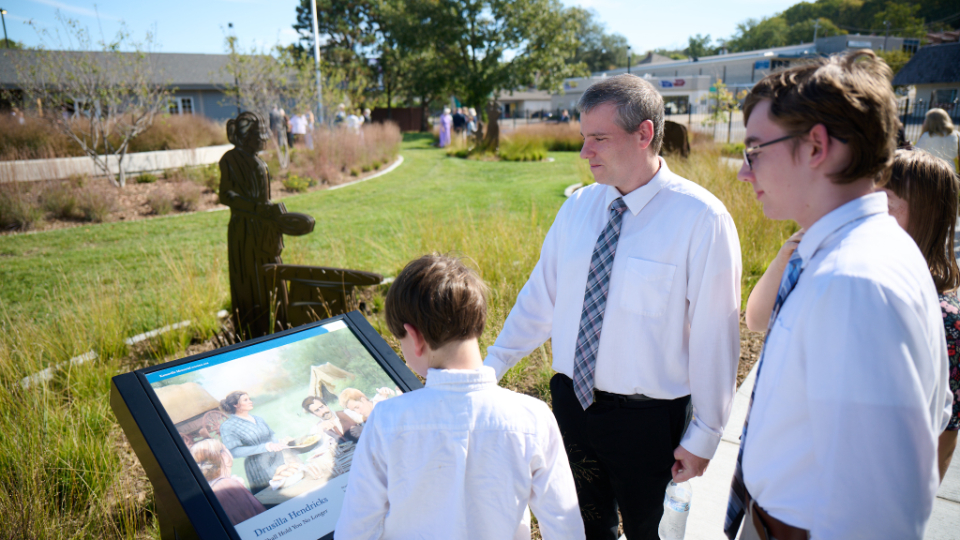The Kanesville Memorial Historic Site of The Church of Jesus Christ of Latter-day Saints has completed reinterpretation work and is open for free tours.
On Saturday, September 28, 2024, Elder Kyle S. McKay, Church Historian and Recorder, dedicated the site. He also gave brief remarks, as did Council Bluffs Mayor Matt Walsh. Local government and religious leaders attended the dedicatory service.
In the dedicatory prayer, Elder McKay said, “We express gratitude for this site and the opportunity it provides to commemorate the faith and sacrifice of early Saints. We pray that in a special, sacred way, they might be given to know of our profound gratitude and admiration for them. Above all, we give honor and praise and glory unto Thee and Thy Son, Jesus Christ, for Thy goodness and mercy, Thy kindness and love.”
-
- Kanesville-Memorial
- Kanesville-Memorial
- Kanesville-Memorial-Dedication
- Kanesville-Memorial-Dedication
- Kanesville-Memorial-Dedication
- Kanesville-Memorial-Dedication
- Kanesville-Memorial
- Kanesville-Memorial-Dedication
- Kanesville-Memorial
- Kanesville-Memorial
- Kanesville-Memorial-Dedication
- Kanesville-Memorial
- Kanesville-Memorial-Dedication
- Kanesville-Memorial
- Kanesville-Memorial-Dedication
- Kanesville-Memorial-Dedicaton
- Kanesville-Memorial
- Kanesville-Memorial
- Kanesville-Memorial
- Kanesville-Memorial
- Kanesville-Memorial
| Temple Square is always beautiful in the springtime. Gardeners work to prepare the ground for General Conference. © 2012 Intellectual Reserve, Inc. All rights reserved. | 1 / 2 |
The Kanesville Memorial Historic Site is among 30 historic sites operated by the Church across the United States. The purpose of these sites is to share a witness to the restoration of the Church of Jesus Christ and highlight the heritage of the Latter-day Saints. They help visitors understand significant events in the Church’s history, their connection to teachings of the Church and their ties to local history.
Early Latter-day Saints gathered in Iowa and Nebraska in 1846 after fleeing religious persecution in Nauvoo, Illinois. In late winter and early spring, they struggled across the muddy terrain of Iowa and found refuge along the banks of the Missouri River. This region served as a haven for them as they prepared to emigrate to a new home in the West. Although they understood their stay would be temporary, they built homes, farms, businesses, and meetinghouses. This infrastructure supported a continual westward flow of Latter-day Saints to their gathering place in the Great Basin of present-day Utah.
One of the largest settlements was in present-day Council Bluffs, Iowa. It served as headquarters for Latter-day Saints in the area between 1847 and 1852. In 1848, Latter-day Saints named the settlement Kanesville, after Thomas L. Kane, a friend of the Church and an advocate on their behalf with the United States government.
“Today we honor Thomas Kane and people like him, then and now,” said Church History Department Managing Director Matthew J. Grow. “These are individuals who see suffering and cannot stand by idle. Individuals who recognize bigotry and cannot stand by silent. Individuals who befriend the friendless, who stand up for those on the margins of society, who minister to others as Jesus Christ would.”
- Kanesville-Dedication
- Kanesville-Memorial
- Kanesville-Dedication
- Kanesville-Dedication
- Kanesville-Memorial
- Kanesville-Memorial
- Kanesville-Dedication-
- Kanesville-Dedication
- Kanesville-Tabernacle
- Kanesville-Dedication
| Temple Square is always beautiful in the springtime. Gardeners work to prepare the ground for General Conference. © 2012 Intellectual Reserve, Inc. All rights reserved. | 1 / 2 |
Elder McKay also paid tribute to Thomas Kane in his remarks. “In memory and honor of Thomas Kane, I invite each of you to go forth and care for the downtrodden and oppressed, to take the time to recognize beauty and worth in those who are overlooked or pushed aside by society, and to actively believe the truth that every child of God is worthy of love,” he said.
Speaking at the dedication Matt Walsh, Mayor of Council Bluffs, Iowa said, "Thankfully [the Church] stayed true to their commitment to the city of Council Bluffs [by working together through the reinterpretation process and outcome] and this beautiful garden behind us, which continues to draw people, is a significant community attraction. And so, thank you to the membership of the Church.
The newly rededicated Kanesville Memorial Historic Site is located on East Broadway Street in downtown Council Bluffs. The memorial features native landscaping, historical waysides, bronze sculptures, and new monuments created by Omaha artist Matthew Placzek. It highlights the faith in Jesus Christ exhibited by early Latter-day Saints and commemorates three events that occurred in the area:
- The mustering of the Mormon Battalion, a group of over 500 volunteers requested by the United States government for the Mexican-American War in 1846. The new memorial recognizes the courage and faith of those who stayed behind when the battalion marched from the Iowa Territory to San Diego, California.
- The reorganization of the First Presidency, the highest governing body in The Church of Jesus Christ of Latter-day Saints, in 1847. At that reorganization, Brigham Young became the President of the Church.
- The return of Oliver Cowdery, one of the first leaders of the Church. After being separated from the Church and its members for 10 years, Cowdery traveled to Kanesville in 1848 and rejoined the Church.
 Download Photo
Download PhotoReflecting on Oliver Cowdery’s return Elder McKay said, “His meek return here in Kanesville marked a joyous, historic day for the Church, and is a tender example to all who have felt alienated through the wrongdoing of self or others.”
The experience at the memorial is self-guided, allowing visitors to move through the site at their own pace. A welcome center provides restrooms, drinking water, and exhibits and films that share additional stories about the site. Admission is free. Additional information about visiting the site is available at ChurchofJesusChrist.org/visitkanesvillememorial.